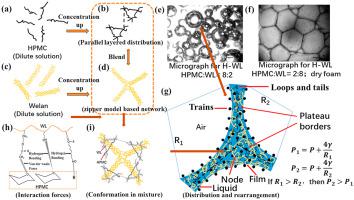当前位置:
X-MOL 学术
›
Food Hydrocoll.
›
论文详情
Our official English website, www.x-mol.net, welcomes your
feedback! (Note: you will need to create a separate account there.)
Foaming and rheological properties of hydroxypropyl methylcellulose and welan gum composite system: The stabilizing mechanism
Food Hydrocolloids ( IF 11.0 ) Pub Date : 2021-03-01 , DOI: 10.1016/j.foodhyd.2020.106275
Jingsong Zhu , Zhuojia Qian , Mohamed Eid , Fuchao Zhan , Muhammad Asif Ismail , Jing Li , Bin Li
Food Hydrocolloids ( IF 11.0 ) Pub Date : 2021-03-01 , DOI: 10.1016/j.foodhyd.2020.106275
Jingsong Zhu , Zhuojia Qian , Mohamed Eid , Fuchao Zhan , Muhammad Asif Ismail , Jing Li , Bin Li

|
Abstract This work reported the effect of welan gum (WL) on stabilizing the foam of hydroxypropyl methylcellulose (HPMC), which compared to konjac glucomannan (KGM) and guar gum (GG). The effects of total concentration and ratio on the foaming properties of the HPMC/WL composite system were studied systematically through the analysis of foaming capacity, foam stability, foam morphology at the macro and micro levels, rotational rheology properties, interface rheology properties, and microstructure. Finally, the interaction forces, conformation, distribution, and rearrangement of HPMC/WL molecules on the interface were speculated to elucidate the stability mechanism. The experimental results showed that when the concentration was 1%, and the ratio of HPMC/WL was 8:2, the foaming capacity was the maximum, reaching 586.66%; when the total concentration was fixed at 1%, the ratio of HPMC/WL was 2:8, the foam stability reached 96.507%. The excellent shear-thinning ability of WL was one crucial factor for the excellent foaming properties of HPMC/WL composite. The high apparent viscosity significantly improved the foam stability of HPMC/WL composite, which was mainly caused by the physical interaction between HPMC and WL molecules after whipping. In addition, the composite foam of HPMC/WL after vacuum freeze-drying presented a porous, dense, and uniform cellular structure. This study expanded the application of WL as a stabilizer for a heterogeneous system and raw material for the carrier of bioactive substances in the delivery system.
中文翻译:

羟丙基甲基纤维素和威兰胶复合体系的发泡和流变特性:稳定机制
摘要 本工作报告了威兰胶 (WL) 与魔芋葡甘露聚糖 (KGM) 和瓜尔豆胶 (GG) 相比对稳定羟丙基甲基纤维素 (HPMC) 泡沫的影响。通过对发泡能力、泡沫稳定性、宏观和微观层面的泡沫形态、旋转流变性能、界面流变性能和微观结构的分析,系统地研究了总浓度和比例对HPMC/WL复合体系发泡性能的影响。 . 最后,推测界面上 HPMC/WL 分子的相互作用力、构象、分布和重排以阐明稳定性机制。实验结果表明,当浓度为1%,HPMC/WL比为8:2时,发泡能力最大,达到586.66%;当总浓度为1%时,HPMC/WL比为2:8,泡沫稳定性达到96.507%。WL 优异的剪切稀化能力是 HPMC/WL 复合材料优异发泡性能的关键因素之一。高表观粘度显着提高了 HPMC/WL 复合材料的泡沫稳定性,这主要是由于 HPMC 与 WL 分子在搅打后的物理相互作用所致。此外,真空冷冻干燥后的 HPMC/WL 复合泡沫呈现出多孔、致密和均匀的蜂窝状结构。该研究扩展了WL作为异质系统稳定剂和递送系统中生物活性物质载体原材料的应用。WL 优异的剪切稀化能力是 HPMC/WL 复合材料优异发泡性能的关键因素之一。高表观粘度显着提高了 HPMC/WL 复合材料的泡沫稳定性,这主要是由于 HPMC 与 WL 分子在搅打后的物理相互作用所致。此外,真空冷冻干燥后的 HPMC/WL 复合泡沫呈现出多孔、致密和均匀的蜂窝状结构。该研究扩展了WL作为异质系统稳定剂和递送系统中生物活性物质载体原材料的应用。WL 优异的剪切稀化能力是 HPMC/WL 复合材料优异发泡性能的关键因素之一。高表观粘度显着提高了 HPMC/WL 复合材料的泡沫稳定性,这主要是由于 HPMC 与 WL 分子在搅打后的物理相互作用所致。此外,真空冷冻干燥后的 HPMC/WL 复合泡沫呈现出多孔、致密和均匀的蜂窝状结构。该研究扩展了WL作为异质系统稳定剂和递送系统中生物活性物质载体原材料的应用。这主要是由鞭打后 HPMC 和 WL 分子之间的物理相互作用引起的。此外,真空冷冻干燥后的 HPMC/WL 复合泡沫呈现出多孔、致密和均匀的蜂窝状结构。该研究扩展了WL作为异质系统稳定剂和递送系统中生物活性物质载体原材料的应用。这主要是由鞭打后 HPMC 和 WL 分子之间的物理相互作用引起的。此外,真空冷冻干燥后的 HPMC/WL 复合泡沫呈现出多孔、致密和均匀的蜂窝状结构。该研究扩展了WL作为异质系统稳定剂和递送系统中生物活性物质载体原材料的应用。
更新日期:2021-03-01
中文翻译:

羟丙基甲基纤维素和威兰胶复合体系的发泡和流变特性:稳定机制
摘要 本工作报告了威兰胶 (WL) 与魔芋葡甘露聚糖 (KGM) 和瓜尔豆胶 (GG) 相比对稳定羟丙基甲基纤维素 (HPMC) 泡沫的影响。通过对发泡能力、泡沫稳定性、宏观和微观层面的泡沫形态、旋转流变性能、界面流变性能和微观结构的分析,系统地研究了总浓度和比例对HPMC/WL复合体系发泡性能的影响。 . 最后,推测界面上 HPMC/WL 分子的相互作用力、构象、分布和重排以阐明稳定性机制。实验结果表明,当浓度为1%,HPMC/WL比为8:2时,发泡能力最大,达到586.66%;当总浓度为1%时,HPMC/WL比为2:8,泡沫稳定性达到96.507%。WL 优异的剪切稀化能力是 HPMC/WL 复合材料优异发泡性能的关键因素之一。高表观粘度显着提高了 HPMC/WL 复合材料的泡沫稳定性,这主要是由于 HPMC 与 WL 分子在搅打后的物理相互作用所致。此外,真空冷冻干燥后的 HPMC/WL 复合泡沫呈现出多孔、致密和均匀的蜂窝状结构。该研究扩展了WL作为异质系统稳定剂和递送系统中生物活性物质载体原材料的应用。WL 优异的剪切稀化能力是 HPMC/WL 复合材料优异发泡性能的关键因素之一。高表观粘度显着提高了 HPMC/WL 复合材料的泡沫稳定性,这主要是由于 HPMC 与 WL 分子在搅打后的物理相互作用所致。此外,真空冷冻干燥后的 HPMC/WL 复合泡沫呈现出多孔、致密和均匀的蜂窝状结构。该研究扩展了WL作为异质系统稳定剂和递送系统中生物活性物质载体原材料的应用。WL 优异的剪切稀化能力是 HPMC/WL 复合材料优异发泡性能的关键因素之一。高表观粘度显着提高了 HPMC/WL 复合材料的泡沫稳定性,这主要是由于 HPMC 与 WL 分子在搅打后的物理相互作用所致。此外,真空冷冻干燥后的 HPMC/WL 复合泡沫呈现出多孔、致密和均匀的蜂窝状结构。该研究扩展了WL作为异质系统稳定剂和递送系统中生物活性物质载体原材料的应用。这主要是由鞭打后 HPMC 和 WL 分子之间的物理相互作用引起的。此外,真空冷冻干燥后的 HPMC/WL 复合泡沫呈现出多孔、致密和均匀的蜂窝状结构。该研究扩展了WL作为异质系统稳定剂和递送系统中生物活性物质载体原材料的应用。这主要是由鞭打后 HPMC 和 WL 分子之间的物理相互作用引起的。此外,真空冷冻干燥后的 HPMC/WL 复合泡沫呈现出多孔、致密和均匀的蜂窝状结构。该研究扩展了WL作为异质系统稳定剂和递送系统中生物活性物质载体原材料的应用。































 京公网安备 11010802027423号
京公网安备 11010802027423号